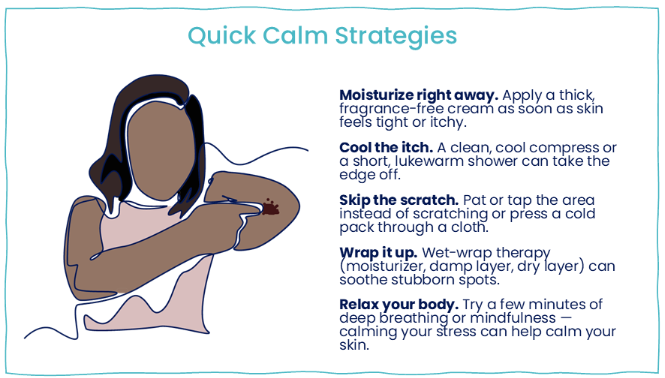
Flare, Itch, Burn, Repeat:
Breaking the Eczema Cycle
One in ten Americans will experience eczema during their lifetimes. And for half of those, eczema will negatively impact their sleep, work, and quality of life. Meanwhile, cases of pediatric eczema have been increasing during the past few decades. The good news is the prevalence of eczema has inspired new research and remedies. So, let’s demystify eczema and look at the ways we can avoid its misery and tame the beast when it appears on our skin.
What Is Eczema?
Eczema is a long-running, on-again/off-again family of inflammatory skin conditions. Something triggers inflammation and it shows up on your skin. Two big things drive it:
- Your skin’s “security system” is leaky. Healthy skin is like a brick wall that keeps water in and irritants out. With eczema, there are gaps in the wall, so moisture escapes and irritants, allergens, and germs can sneak in.
- Your immune system overreacts. Once irritants get through, your immune system sounds the alarm a little too enthusiastically. That causes redness, swelling, and a fierce itch. You scratch, which damages the wall more, which invites more irritation. Round and round we go.
Types of Eczema
Atopic dermatitis is the most ubiquitous member of the eczema family. It’s the classic, chronic, itchy eczema that often starts in childhood. The other eczema family members have complex names but are pretty easy to identify:
- Contact dermatitis: A rash that appears when your skin touches an irritant (like soaps, perfumes, or nickel). This is often caused by an alloy metal in jewelry or a harsh detergent used to wash hotel bedding.
- Seborrheic dermatitis: Greasy, scaly patches often seen on the scalp (“dandruff”) or face.
- Nummular dermatitis: Coin-shaped patches that can look like ringworm but are actually eczema.
- Dyshidrotic dermatitis: Tiny, intensely itchy blisters on the hands and feet that look a little like measles or foot and mouth disease.
- Neurodermatitis: Thickened patches from chronic scratching, often on easily reached areas like the forearm or back of the neck. Neurodermatitis usually starts as untreated atopic dermatitis.
- Stasis dermatitis: Found on the lower legs, linked to poor circulation and swelling. It’s often found in the sedentary elderly.
Each member of the eczema family has its own triggers and quirks, but they all share the hallmark itch and inflammation that define eczema.
How do you know if your eczema is mild, moderate, or severe?
Behind the scenes, medical providers may use scoring tools to grade severity and track progress over time. It all boils down to how much skin is involved, how inflamed it is, how intense the itch is, and how much it disrupts life. So, here’s how the rest of us can gauge the severity of our eczema.
- Mild: Your eczema is mild if it affects small areas, the itch comes and goes, and the flares are usually controlled with moisturizers and mild creams.
- Moderate: Moderate eczema involves larger patches, frequent itching, and begins to interfere with sleep or daily routines.
- Severe: Severe eczema is widespread and intense, disrupts sleep, work, and school, and leads to frequent infections or skin cracking.
What’s happening in a flare?
During a flare, the combo of a leaky-barrier + a jumpy immune system ramps up. Common culprits include dry air, heat, sweat, harsh soaps or detergents, certain fabrics, infections, and even stress. Some people also notice flares with seasonal allergens or after getting run down. Staph bacteria can pile onto the situation and make inflammation worse, which is why some doctor-directed antiseptic strategies (see bleach bath below) can help in select cases.
The Psychological Side
Eczema goes deeper than skin. Itchy nights can steal your sleep, and visible patches might shake your confidence. People with eczema are more likely to experience anxiety or low mood—and stress can make flares even worse. The good news? You can often break the cycle from both sides: calming your skin can help with sleep and mood, and stress-management tools can help your skin chill out, too. Simple add-ons like regular movement, better sleep habits, quick relaxation breaks, mindfulness, or getting back into your usual routines can all support your skin alongside medical care.
How do you prevent flares?
Start with the boring stuff that works.
- Moisturize daily. Use a thick, fragrance-free cream or ointment. Think “seal and protect.”
- Gentle bathing. Take a short, lukewarm bath or shower. Pat yourself dry, then apply medication (if prescribed) to rashy areas and moisturizer everywhere else. Dermatologists call this “soak and seal.”
- Spot your triggers. Switch to fragrance-free detergent, avoid scratchy fabrics, cool down quickly after workouts, and protect your hands from soaps and solvents. It’s a great idea to keep a little eczema journal. When you experience a flare, note the date and any possible triggers (stress, travel, change in fabric, detergent, soap, season, etc.).

What can you do when flares get stubborn?
- Diluted bleach baths can lower skin bacteria and calm inflammation when used correctly and sparingly. Your clinician can confirm whether they fit your plan and how often to use them.
- Wet-wrap therapy is a simple layering trick: first comes moisturizer or medication, then damp wraps, topped with a dry layer. It helps your skin soak up treatments during tough flares and gives it a break from scratching.
When to Call a Medical Provider
- If you have a flare that isn’t calming down after a week of good moisturizer + appropriate topical medicine.
- If you develop yellow crusts, pus, or sudden worsening that may signal infection.
- If your flare is disrupting your sleep, work, or school schedule. Sleep loss, frequent bleeding from scratching, or major disruption to your routine are good reasons to check in.
- If you’re using steroid creams most days and are still flaring.
- If you’re curious about light therapy, biologics, or JAK inhibitors and want to know if you’re a candidate (see below).
Prescription and Advanced Therapies (old and new)
Medical providers almost always start eczema patients with a topical steroid cream. Steroid creams, like triamcinolone acetonide, are very useful for short bursts on active flares because they are fast and effective, but are not for endless daily use on the same spot. Steroid creams are designed to treat skin conditions caused by inflammation, but long-term use of steroid creams can cause side effects like skin thinning, bruising, and stretch marks. Also, since there is some systemic absorption of topical steroids, they create a small risk of systemic issues such as Cushing syndrome, high blood sugar, or adrenal gland suppression.
Some newer non-steroid creams, light therapy, and biologics give more long-term control for people who need it and help reduce the “steroid yo-yo” of clear-flare-clear.
- Non-steroid options are a good choice for sensitive areas or longer-term control. There are three types of non-steroid creams, with each type targeting different inflammation triggers. Calcineurin inhibitors and PDE-4 inhibitors can be used for longer periods of time than steroid creams. Topical JAK inhibitors are for short-term, non-continuous use on limited areas that need extra help; they work by quieting overactive immune signals in the skin.
- Phototherapy in the form of narrowband UVB light can help when creams aren’t enough or when you’d prefer to avoid pills or injections.
- Biologics bind to specific proteins in the immune system, blocking their activity and reducing inflammation. They are a powerful class of drugs used in the treatment of autoimmune and inflammatory diseases and are heavily advertised these days. Despite their power, biologics are fragile and can’t be taken orally because our digestive systems would destroy their efficacy. There are several biologics designed to treat moderate to severe eczema, almost always via injection. These can be extremely effective but also come with some potentially serious side effects, like increased infection risk, so biologics are rarely a first-line treatment for eczema.
- Oral JAK inhibitors are powerful pill options for tougher eczema cases. These drugs may cause more severe side effects than biologics and will only be prescribed with careful safety monitoring in very specific situations.
The Bottom Line
If you’re prone to it, eczema will make itself known when your skin barrier is vulnerable and your immune system is hyper-reactive. Moisturizers and gentle care are your daily defense. Topicals are your flare tools. Light therapy, biologics, and JAK inhibitors are there if you need backup. The goal is simple: fewer flares, less misery, and skin that lets you get on with life.